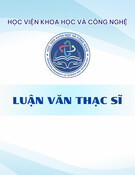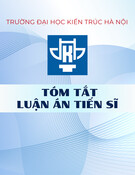
HO CHI MINH NATIONAL ACADEMY OF POLITICS AND
PUBLIC ADMINISTRATION
NGUYEN THI GIANG HUONG
HIGH-QUALITY HUMAN RESOURCE
DEVELOPMENT FOR WOMEN IN VIETNAM
AT PRESENT TIME
Major: The Dialectical Materialism &Historical Materialism
Code : 62 22 80 05
THE DOCTORAL THESIS IN PHYLOSOPHY
Supervisor: Assoc. Prof. Dr. Nguyen Thi Nga
HANOI - 2013

I
DECLARATION OF ORIGINALITY
I hereby declare that the research paper titled “High-Quality Human Resource
Development for Women in Vietnam at Present Time”is my own work and to the best of
my knowledge. Data and materials used in the thesis are real with obvious origins; findings
in this thesis are studied results of the writer.
AUTHOR OF THE THESIS
Nguyen Thi Giang Huong

II
TABLE OF CONTENTS
Page
INTRODUCTION
1
Chapter 1: OVERVIEW OF RESEARCH RELATED TO THE THESIS
6
1.1. The research works related to the thesis
6
1.2. The value of the referenced works and further study
22
Chapter 2: HIGH-QUALITY HUMAN RESOURCE DEVELOPMENT
FOR WOMEN AT PRESENT IN VIETNAM – VIEWED FROM THE
RELATIONSHIP BETWEEN THE OBJECTIVE CONDITIONS AND
SUBJECTIVE ACTORS
25
2.1. Some basic concepts
25
2.2. The importance of high-quality human resource development for women in
Vietnam today
45
2.3. The objective conditions and subjective factors affecting high-quality human
resource development for women in Vietnam today
57
Chapter 3: HIGH-QUALITY HUMAN RESOURCE DEVELOPMENT
FOR WOMEN AT PRESENT IN VIETNAM - CURRENT
SITUATION AND EMERGING ISSUES
70
3.1. High-quality human resource development for women in Vietnam at the
present- situation and causes
70
3.2. Some issues raised in the development of high quality human resource for
women in Vietnam today
100
Chapter 4: KEY SOLUTIONS TO HIGH-QUALITY HUMAN
RESOURCE DEVELOPMENT FOR WOMEN IN VIETNAM
AT PRESENT TIME
114
4.1. Solutions related to the objective conditions for the development of high
quality human resource for women
114
4.2. Solutions related to the subjective factor in the development of high-quality
human resource for women
124
CONCLUSION
146
LIST OF AUTHOR’S PUBLISHED SCIENTIFIC WORKS
149
LIST OF REFERENCES
150
APPENDIX
161

III
LIST OF ABBREVIATIONS
BCH : Committee
BTV : Standing Committee
CĐ, ĐH và sau ĐH : Undergraduate and Graduate
CNH, HĐH : Industrialization and Modernization
HĐND : People’s Council
NNLNCLC : High-Quality Female Human Resource
NNLCLC : High-Quality Human Resource
NNLN : Female Human Resource
NNL : Human Resource
QH : National Assembly
TCCN và TC nghề: Vocational Training
TW : Central level

IV
LIST OF TABLES
Page
Table 3. 1:
Distribution of labor force by qualification in 2010
70
Table 3.2:
Distribution of workforce by urban - rural level in 2010
72
Table 3.3:
NNLN Distribution by region and by level in 2010
73
Table 3.4:
Percentage distribution NLNCLC by qualification engaged in
socio- economic activities
84
Table 3.5:
Percentage NNLNCLC having academic titles in the 2007 – 2011
76
Table 3.6:
Percentage of women in the Executive Board (EB) of the Party
from 1991 to 2015
80
Table 3.7:
Rate of female workforce positions in the Party Committees
81
Table 3 8:
Rate of female workforce holding positions in Parliament
83
Table 3.9:
Percentage of women in the People’s Council 1989 – 2016
84
Table 3.10:
Percentage female human holding the titles of People’s Councils
85
Table 3.11:
Percentage of female labor leaders, management of the Central
State
86
Table 3.12:
Percentage of female workforce participation level People’s
Committees
89
Table 3.13:
Some basic indicators related to maternity care, 2001 – 2009
96
Table 3.14:
Number of hours worked by the average per person/per day
ational level
97
Table 3.15:
Average income/month NNLCLC
109





![Luận văn Thạc sĩ: Tổng hợp và đánh giá hoạt tính chống ung thư của hợp phần lai tetrahydro-beta-carboline và imidazo[1,5-a]pyridine](https://cdn.tailieu.vn/images/document/thumbnail/2025/20250816/vijiraiya/135x160/26811755333398.jpg)




















